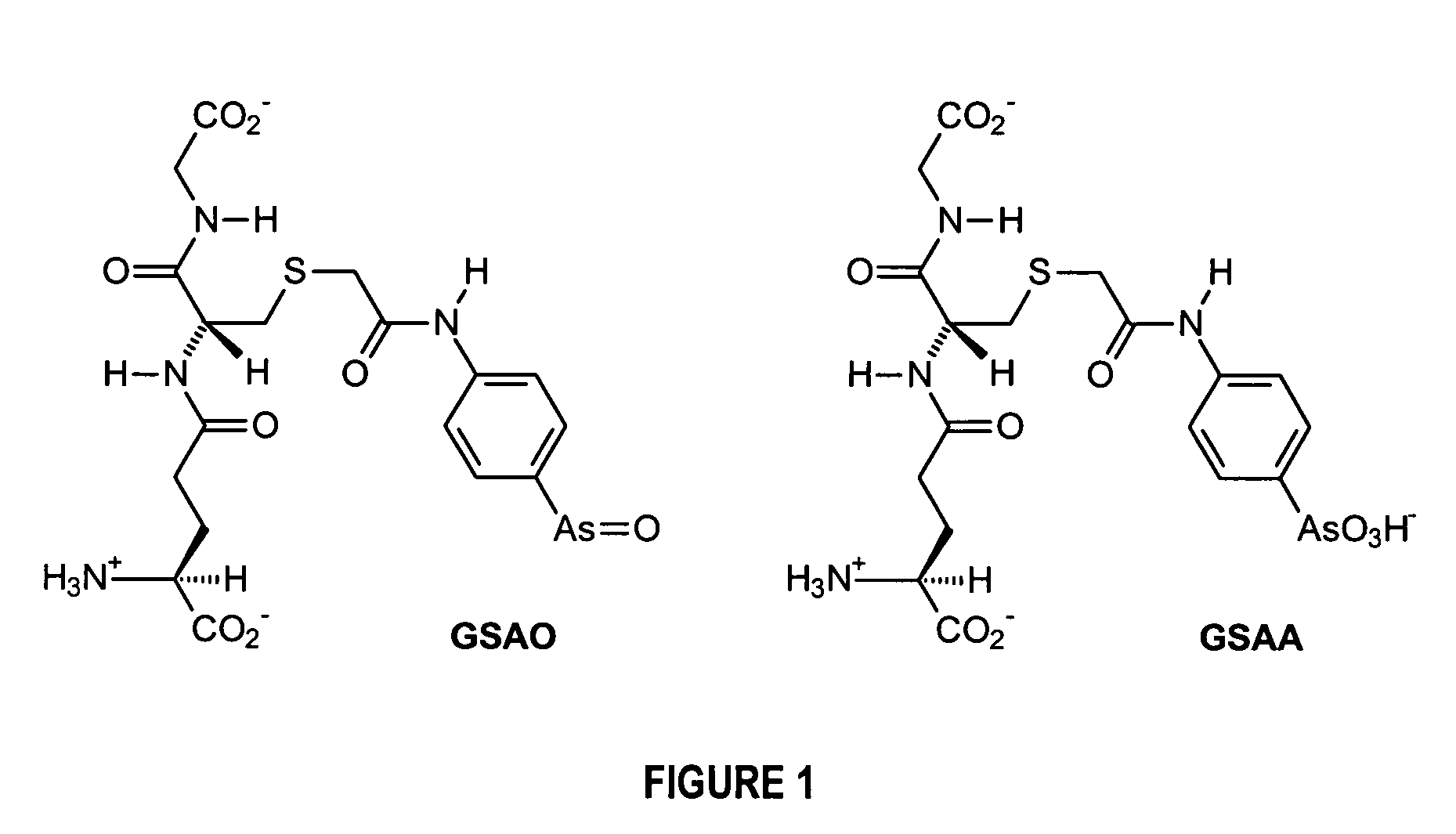Substantially cell membrane impermeable compound and use thereof
- Summary
- Abstract
- Description
- Claims
- Application Information
AI Technical Summary
Benefits of technology
Problems solved by technology
Method used
Image
Examples
example 1
Synthesis of Compounds of the Invention
[0237]The following chemicals were purchased and used without further purification: phenylarsenoxide, bromoacetyl bromide, sulfur dioxide, d6-dimethylsulfoxide, deuterium oxide, L-aspartic acid, L-glutamic acid, D-glucosamine hydrochloride (Aldrich, Castle Hill, NSW); methanol, 98% sulfuric acid, 48% hydrobromic acid, 37% hydrochloric acid (Ajax, Auburn, NSW); dichloromethane, potassium hydroxide, sodium hydrogen carbonate, sodium hydroxide (BDH, Kilsyth, VIC); P-2 Gel extra fine 1,800 MW cut-off (Bio-Rad, Hercules, Calif.); 2,3-dimercaptopropanol (DMP), L-cysteic acid (Fluka, Castle Hill, NSW); thionyl chloride (Merck, Darmstadt, Germany); 6,8-thioctic acid, dithiothreitol, dimethylsulfoxide, 5,5′-dithiobis(2-nitrobenzoic acid), ethylenediaminetetraacetic acid, N-(2-hydroxyethyl)piperazine-N′-(2-ethanesulfonic acid), glutathione, sodium carbonate, sodium chloride, sodium iodide (Sigma, Castle Hill, NSW); p-arsanilic acid (Tokyo Kasei Kogyo, To...
example 1 (
EXAMPLE 1(q)
Synthesis of N-(3-(4-arsenosophenylcarbamoylmethylthio)propanoyl)-D-glucosamine (GIcAO)
[0272]The procedure used was the same as for N-(3-(4-arsenosophenylcarbamoylmethylthio)propanoyl)-L-glutamic acid, using 3.00 mL (210 μmol) of 70.0 mM BRAO in DMSO, the disulfide of disodium N-(3-mercaptopropanoyl)-D-glucosamine (0.67 g), 0.5 M bicarbonate buffer, pH 9 (11.96 mL, 6.0 mmol), and 0.69 M triphenylphosphine in DMSO (1.9 mL, 1.3 mmol). The active concentration of trivalent arsenic was found to be 13.5 mM (11.0 mL of solution).
example 2
Assay and Reactivity of GSAO
EXAMPLE 2(a)
Assay of BRAO, GSAO and GSAO-B
[0273]A stock solution of DMP (5 μL, 50 μmol) was dissolved in DMSO (995 μL), giving a concentration of 50 mM DMP. A second dilution of the 50 mM DMP stock solution (10 μL) in pH 7.0 buffer (0.1 M HEPES, 0.3 M NaCl, 1 mM EDTA) (990 μL) gave a working solution of 500 M DMP. The activity of the arsenical could then be determined by the titration of varying amounts of arsenical against the DMP working solution (10 μL) in a 96-well microtitre plate, with the total volume made up to 195 μL by addition of buffer. After a 10 minute incubation at room temperature, during which time the solutions were agitated on a plate shaker, 5 μL of a 37.9 mM stock solution of DTNB (15 mg) in DMSO (1 mL) was added, and the plate incubated with shaking for another 10 minutes. The absorbance at 412 nm due to the formation of the TNB dianion was measured using a Molecular Devices Thermomax Plus (Palo Alto, Calif.) microplate reader. The e...
PUM
| Property | Measurement | Unit |
|---|---|---|
| dissociation constants | aaaaa | aaaaa |
| temperature | aaaaa | aaaaa |
| volume | aaaaa | aaaaa |
Abstract
Description
Claims
Application Information
 Login to View More
Login to View More - R&D
- Intellectual Property
- Life Sciences
- Materials
- Tech Scout
- Unparalleled Data Quality
- Higher Quality Content
- 60% Fewer Hallucinations
Browse by: Latest US Patents, China's latest patents, Technical Efficacy Thesaurus, Application Domain, Technology Topic, Popular Technical Reports.
© 2025 PatSnap. All rights reserved.Legal|Privacy policy|Modern Slavery Act Transparency Statement|Sitemap|About US| Contact US: help@patsnap.com



